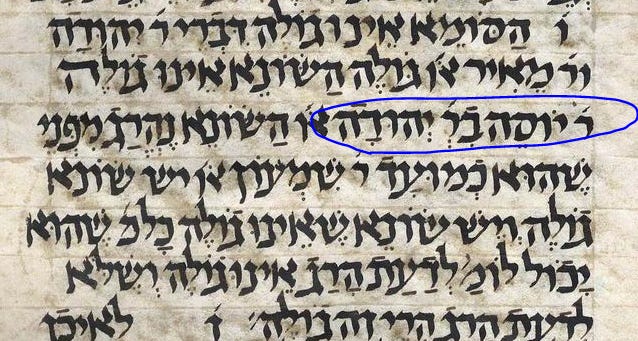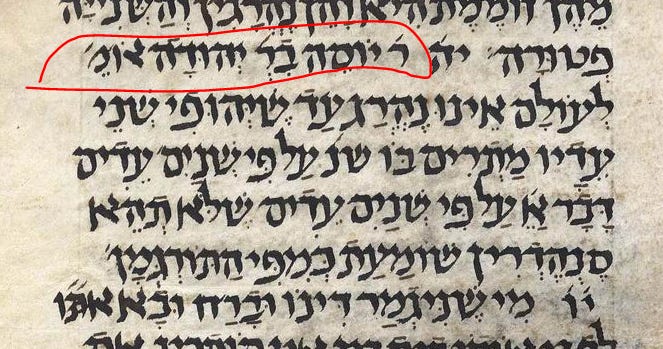"It is Rabbi Yossi b. Rabbi Yehuda" But in which Mishnah?
A curious exchange in yesterday’s daf, Makkot 6b:
רַבִּי יוֹסֵי אוֹמֵר וְכוּ׳. אֲמַר לֵיהּ רַב פָּפָּא לְאַבָּיֵי: וּמִי אִית לֵיהּ לְרַבִּי יוֹסֵי הַאי סְבָרָא? וְהָתְנַן רַבִּי יוֹסֵי אוֹמֵר: הַשּׂוֹנֵא – נֶהֱרָג, מִפְּנֵי שֶׁהוּא כְּמוּעָד וּמוּתְרֶה.
§ The mishna teaches that Rabbi Yosei says: Perpetrators are never executed unless his two witnesses are the ones forewarning him. Rav Pappa said to Abaye: And is Rabbi Yosei of the opinion that this line of reasoning is correct, and forewarning by the witnesses is indispensable? But didn’t we learn in a mishna (9b): Rabbi Yosei says: An enemy who commits murder cannot claim that he killed the victim unwittingly. Rather, he is executed even if there was no forewarning, due to the fact that his halakhic status is like that of one who is cautioned and forewarned. Apparently, Rabbi Yosei does not always require that there be forewarning.
אֲמַר לֵיהּ: הָהוּא – רַבִּי יוֹסֵי בַּר יְהוּדָה הִיא. דְּתַנְיָא: רַבִּי יוֹסֵי בַּר יְהוּדָה אוֹמֵר: חָבֵר אֵין צָרִיךְ הַתְרָאָה, לְפִי שֶׁלֹּא נִיתְּנָה הַתְרָאָה אֶלָּא לְהַבְחִין בֵּין שׁוֹגֵג לְמֵזִיד.
Abaye said to him: That statement in the mishna you cited that is attributed to Rabbi Yosei is actually the opinion of Rabbi Yosei bar Yehuda, as it is taught in a baraita: Rabbi Yosei bar Yehuda says: A ḥaver does not require forewarning, as forewarning was instituted only to distinguish between one who commits a transgression unwittingly and one who does so intentionally. A ḥaver, who is a Torah scholar, does not require forewarning to distinguish between them. Rabbi Yosei ben Ḥalafta, whose opinion is cited in the mishna here, is of the opinion that forewarning is a necessary prerequisite to executing someone who is judged liable, and that forewarning must be issued by the witnesses.
In other words, in our local Mishnah earlier on Makkot 6b, it is the Tanna Kamma followed by the regular Rabbi Yossi, that is, fifth-generation Tanna Rabbi Yossi bar Chalafta. And he’s the one who requires warning.
Meanwhile, in the later Mishnah on Makkot 9b, the plain Rabbi Yossi is a different Tanna, Rabbi Yossi b. Rabbi Yehuda. This is a sixth-generation Tanna, the son of the plain Rabbi Yehuda, who is Rabbi Yehuda b. Illai. You can read about him in Toledot Tannaim vaAmoraim here. This is the one who does not require warning.
Now, this answer that Abaye gives Rav Pappa is echoed in several other sugyot. For example, in that selfsame sugya on 9b, where the gemara asks and answers the question, without mentioning Abaye and Rav Pappa. In other sugyot, such as Sanhedrin 72b, the suggestion is made that a brayta is in accordance with Rabbi Yossi beRabbi Yehuda.
Now, that Mishnah on 9b reads:
מַתְנִי׳ הַסּוֹמֵא אֵינוֹ גּוֹלֶה, דִּבְרֵי רַבִּי יְהוּדָה. רַבִּי מֵאִיר אוֹמֵר: גּוֹלֶה. הַשּׂוֹנֵא אֵינוֹ גּוֹלֶה. רַבִּי יוֹסֵי אוֹמֵר: הַשּׂוֹנֵא נֶהֱרָג, מִפְּנֵי שֶׁהוּא כְּמוּעָד. רַבִּי שִׁמְעוֹן אוֹמֵר: יֵשׁ שׂוֹנֵא גּוֹלֶה וְיֵשׁ שׂוֹנֵא שֶׁאֵינוֹ גּוֹלֶה. זֶה הַכְּלָל: כֹּל שֶׁהוּא יָכוֹל לוֹמַר לְדַעַת הָרַג – אֵינוֹ גּוֹלֶה, וְשֶׁלֹּא לְדַעַת הָרַג – הֲרֵי זֶה גּוֹלֶה.
MISHNA: A blind person who unintentionally murdered another is not exiled; this is the statement of Rabbi Yehuda. Rabbi Meir says: He is exiled. The enemy of the victim is not exiled, as presumably it was not a completely unintentional act. Rabbi Yosei says: Not only is an enemy not exiled, but he is executed by the court, because his halakhic status is like that of one who is forewarned by witnesses not to perform the action, as presumably he performed the action intentionally. Rabbi Shimon says: There is an enemy who is exiled and there is an enemy who is not exiled. This is the principle: In any case where an observer could say he killed knowingly, where circumstances lead to the assumption that it was an intentional act, the enemy is not exiled, even if he claims that he acted unintentionally. And if it is clear that he killed unknowingly, as circumstances indicate that he acted unintentionally, he is exiled, even though the victim is his enemy.
This bothers me a little bit, because of the sandwiching. You can know a fellow by the company he keeps, and if we have:
Rabbi Yehuda
Rabbi Meir
Rabbi Yossi
Rabbi Shimon
all plain, then my first guess will be that we are dealing with the typical chabura of fifth-generation Amoraim. The stam Rabbi Yossi should be fifth-generation Rabbi Yossi ben Chalafta. It is indeed misleading to use a stam Rabbi Yossi to mean a different Tanna in this context.
That is, I can accept that a stam name without a patronymic can refer to all sorts of different Sages. It could be that local to a certain tight scholastic network, Rabbi Yossi son of Rabbi Yehuda was just known as Rabbi Yossi. And this only becomes a “problem” of ambiguity when we have a joining of these local scholastic networks into a global scholastic network. But here, plain Rabbi Yossi already has a meaning in this very tight scholastic network!
We could say that Abaye is making a kvetch here to make it work, and Rav Pappa’s question is indeed quite solid. However, I think that we can mount a strong defense of Abaye.
First, it is not like all these Tannaim they are all arguing with one another in the Mishnah on 9b. Rabbi Yehuda and Rabbi Meir argue about a blind person. Rabbi Yossi (beRabbi Yehuda) argues with a Tanna Kamma about an enemy, and then Rabbi Shimon (from one earlier generation) weighs in to kind of be machria.
I don’t think Abaye made it up. And I don’t think he is arguing that this was a stam Rabbi Yossi but that stam here means a different Tanna. Rather, he is correcting Rav Pappa’s version, girsa, of the Mishnah. Don’t read “Rabbi Yossi” but “Rabbi Yossi beRabbi Yehuda”.
What makes me think this is the girsa in the standard Mishnah (of 9b, that is, Mishnah Makkot 2:3). It reads:
הָאָב גּוֹלֶה עַל יְדֵי הַבֵּן, וְהַבֵּן גּוֹלֶה עַל יְדֵי הָאָב. הַכֹּל גּוֹלִין עַל יְדֵי יִשְׂרָאֵל, וְיִשְׂרָאֵל גּוֹלִין עַל יְדֵיהֶן, חוּץ מֵעַל יְדֵי גֵּר תּוֹשָׁב. וְגֵר תּוֹשָׁב אֵינוֹ גוֹלֶה אֶלָּא עַל יְדֵי גֵּר תּוֹשָׁב. הַסּוּמָא אֵינוֹ גוֹלֶה, דִּבְרֵי רַבִּי יְהוּדָה. רַבִּי מֵאִיר אוֹמֵר, גּוֹלֶה. הַשּׂוֹנֵא אֵינוֹ גוֹלֶה. רַבִּי יוֹסֵי בַּר יְהוּדָה אוֹמֵר, הַשּׂוֹנֵא נֶהֱרָג, מִפְּנֵי שֶׁהוּא כְמוּעָד. רַבִּי שִׁמְעוֹן אוֹמֵר, יֵשׁ שׂוֹנֵא גוֹלֶה וְיֵשׁ שׂוֹנֵא שֶׁאֵינוֹ גוֹלֶה. זֶה הַכְּלָל, כֹּל שֶׁהוּא יָכוֹל לוֹמַר לְדַעַת הָרַג, אֵינוֹ גוֹלֶה. וְשֶׁלֹּא לְדַעַת הָרַג, הֲרֵי זֶה גוֹלֶה:
The father is exiled to a city of refuge due to his unintentional murder of his son. And the son is exiled due to his unintentional murder of his father. Everyone is exiled due to their unintentional murder of a Jew, and a Jew is exiled due to his unintentional murder of any of them, except for the unintentional murder of a gentile who resides in Eretz Yisrael and observes the seven Noahide mitzvot [ger toshav]. And a ger toshav is exiled only due to his unintentional murder of a ger toshav. A blind person who unintentionally murdered another is not exiled; this is the statement of Rabbi Yehuda. Rabbi Meir says: He is exiled. The enemy of the victim is not exiled, as presumably it was not a completely unintentional act. Rabbi Yosei says: Not only is an enemy not exiled, but he is executed by the court, because his halakhic status is like that of one who is forewarned by witnesses not to perform the action, as presumably he performed the action intentionally. Rabbi Shimon says: There is an enemy who is exiled and there is an enemy who is not exiled. This is the principle: In any case where an observer could say he killed knowingly, where circumstances lead to the assumption that it was an intentional act, the enemy is not exiled, even if he claims that he acted unintentionally. And if it is clear that he killed unknowingly, as circumstances indicate that he acted unintentionally, he is exiled, even though the victim is his enemy.
Or, in Ktav Yad Kaufmann of the Mishnah:
So too in that Mishnah in Yerushalmi:
משנה: הָאָב גּוֹלֶה עַל יְדֵי בְּנוֹ וְהַבֵּן עַל יְדֵי הָאָב. הַכֹּל גּוֹלִים עַל יְדֵי יִשְׂרָאֵל וְיִשְׂרָאֵל גּוֹלִים עַל יְדֵיהֶם חוּץ מֵעַל יְדֵי גֵּר תּוֹשָׁב. וְגֵר תּוֹשָׁב גּוֹלֶה עַל יְדֵי גֵּר תּוֹשָׁב. הַסּוּמֶא אֵינוֹ גוֹלֶה דִּבְרֵי רִבִּי יְהוּדָה. רִבִּי מֵאִיר אוֹמֵר גּוֹלֶה. הַשּׂוֹנֵא אֵינוֹ גוֹלֶה. רַבִּי יוֹסֵי בֵּי רִבִּי יְהוּדָה אוֹמֵר הַשּׂוֹנֵא נֶהֱרָג מִפְּנֵי שֶׁהוּא כְמוּעָד. רִבִּי שִׁמְעוֹן אוֹמֵר יֵשׁ שׂוֹנֵא גּוֹלֶה וְיֵשׁ שֶׁאֵינוֹ גוֹלֶה. כֹּל שֶׁהוּא יָכוֹל לוֹמַר לָדַעַת הָרַג אֵינוֹ גוֹלֶה. וְשֶׁלֹּא לָדַעַת הָרַג הֲרֵי זֶה גּוֹלֶה׃
Or, in the Leiden Yerushalmi manuscript of that Mishnah:
So, Abaye either speculated correctly about the identity of this stam Rabbi Yossi, or, more likely, he was aware of the correct girsa, for which we have corroboration in other Mishnaic texts, including in the Yerushalmi.
The slight issue is that, OK, that is the Mishnah on 9b. What about the Mishnah on 6b, which was plain Rabbi Yossi? Indeed, besides our Bavli’s Mishnah having this as plain Rabbi Yossi, this is also plain Rabbi Yossi in the printed Mishnah for Mishnah Makkot 1:9.
Move on the the Kaufmann manuscript, the only complete Mishnah manuscript, and you will see that it also has Rabbi Yossi beRabbi Yehuda:
Not only that, in the Mishnah in the Yerushalmi as well, it is Rabbi Yossi beRabbi Yehuda. In both these images, it is Mishnah 15 where it appears.
This could perhaps be a scribal error. However, I have a sneaking suspicion that this is not a scribal error, and that Abaye meant to refer to both Mishnayot in this manner. I don’t yet know how this would work, and have to ruminate a bit on it. Can this work, and if so, would it work with how the Talmudic Narrator frames it? Bli neder, and if I can figure it out, I hope to address it in a follow-up post.







